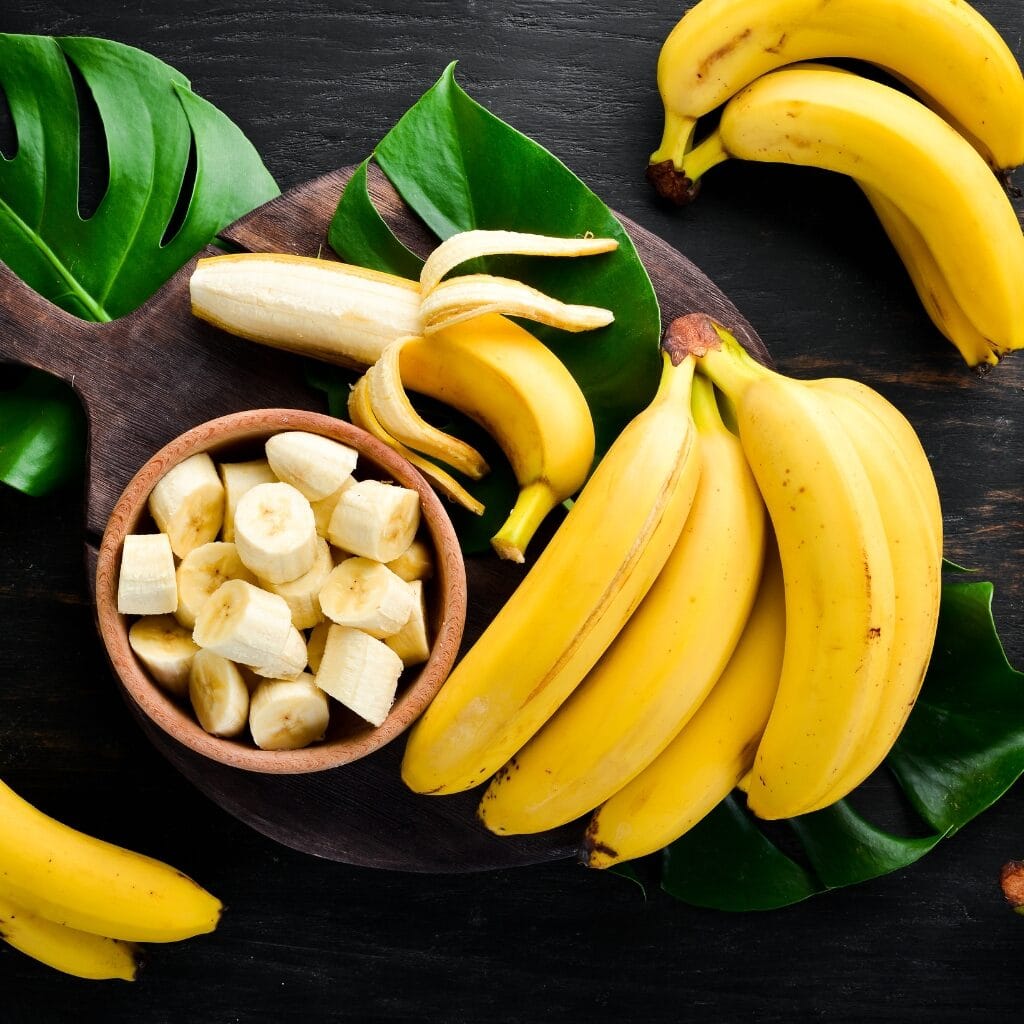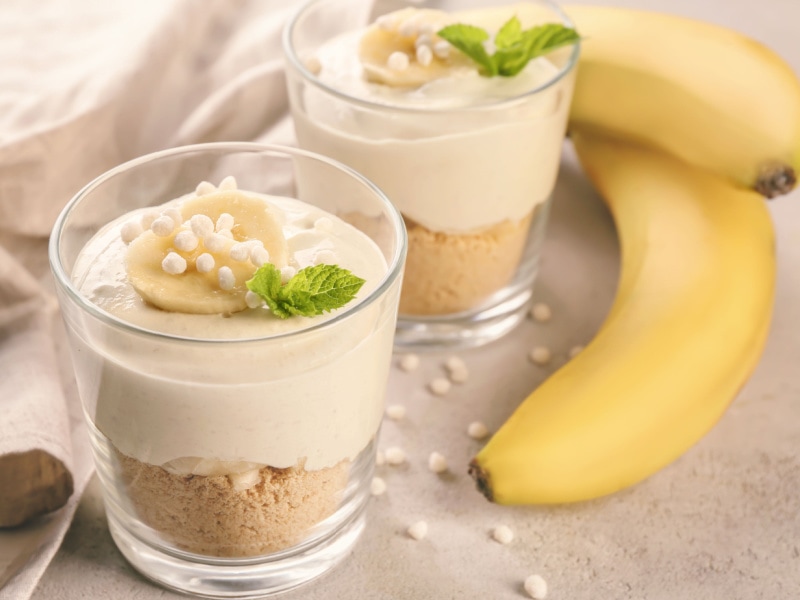Let’s settle the plantains vs. bananas debate once and for all!
You might be asking yourself, “What are plantains? What are bananas? How are they different, and how do you cook with each of them?”
Don’t worry!

I’ll answer all of those questions for you. Because despite what some people might think, plantains and bananas are different.
They might look a lot alike, but nearly everything else about them is not the same.
So settle in and get ready to examine plantains vs. bananas. You just might learn something new today!

What Are Bananas?
Asking, ‘What are bananas?’ may seem a little weird.
After all, we’ve all seen the popular yellow fruit in our homes, schools, stores, and everywhere else.
Bananas are just as commonly consumed as apples and oranges!
But let’s go beyond the fact that they’re sweet yellow-peeled fruits. Let’s dive a little deeper.
Bananas come from the family Musaceae. Popular varieties include Musa acuminata, Musa balbisiana, and Musa × paradisiaca.
They’re pretty unique among fruits because they aren’t just fruits.
They’re also berries and herbs! Botanically, they’re classified as berries and fruits.
However, they grow on herbaceous trees, making them herbs, as well. Pretty exciting stuff, right?
They’re sweet and soft when ripe, and most varieties feature the iconic yellow peel.
They’re high in potassium and low in calories. You can enjoy them cooked or raw.

What Are Plantains?
Plantains also come from the family Musaceae and fall under the Musa genus.
Also, like bananas, they are relatively low in calories and high in potassium.
Their shape resembles bananas, though they typically grow larger and longer.
They have thick skins ranging in color from brown to yellow to green.
They are sweet when ripe, though not as sweet as bananas.
They’re also extremely fibrous and starchy. For that reason, most people don’t eat them raw.
Instead, they cook them and use them in various recipes.
Frying, baking, and boiling are some of the most common ways to prepare plantains.
Native to Asia, like bananas, plantains now grow all over the world.
They need warm, tropical climates to grow naturally.
However, people also cultivate them using artificial environments.

Plantains vs. Bananas (What’s the Difference?)
There are several differences between bananas and plantains.
I’ve touched on a few of them already, but I’ll break them down more clearly in the following sections.
Appearance
Both fruits have a similar shape. They are relatively thin, slightly curved, and elongated.
However, bananas are bright yellow when ripe. (There are a few exceptions.)
Plantains, on the other hand, come in several different colors.
They’re also bigger than bananas, on average. Some plantains are almost twice as long as bananas.
The ends of both fruits also look very different. Bananas’ ends are slightly rounded, whereas plantains end in points.
Plantains’ peels are much thicker than bananas’ peels, too.
Nutrition and Health Benefits
Bananas and plantains have similar nutritional profiles, but they aren’t identical.
For example, plantains are higher in calories and carbs than bananas. They also have more potassium.
Bananas, though, have far more natural sugar than plantains. Plantains have more starch.
Studies suggest that both may help prevent heart disease and regulate blood sugar.
They’re also decent sources of fiber and aid in digestion.
Shelf Life and Price
Plantains have much longer shelf lives than bananas. After a banana ripens, it quickly becomes overripe and then spoiled.
Plantains, on the other hand, take a longer time to go from ripe to ruined. Like most fruits and veggies, they won’t last forever.
Still, they stay fresh far longer than bananas.
As for price, bananas are typically cheaper. Even though they ruin faster, they are much more widely available everywhere.
The cost of plantains can be almost double that of bananas.
Taste
Bananas are much, much sweeter than plantains.
As long as they’ a’re ripe, they taste fantastic eaten raw. Plantains, though, aren’t very sweet at all.
They have some natural sweetness but compared to bananas, it’s almost unnoticeable.
Plantains taste best when cooked, but even then, they aren’t sweet.
Instead, they’re starchy and lend themselves well to both sweet* and savory recipes.
*Note: When using plantains in sweet recipes, you typically have to add sweeteners to them.
Culinary Uses
As I mentioned, you can eat bananas raw or cooked. When cooked, they typically appear in dessert recipes.
Banana bread, banana pudding, and banana muffins are all standard recipes.
Most people treat plantains as vegetables when cooking them.
There are some sweet plantain recipes out there, but they are few and far between.
And even when sweetened with sweeteners, plantain desserts aren’t as sweet as banana ones.
Plantains aren’t good when consumed raw.

How to Cook Bananas
I’ve already mentioned that most banana recipes are sweet.
These include dessert recipes and baked goods like muffins, bread, and cakes.
Usually, people mash bananas when cooking with them.
However, some recipes, like banana pudding, use banana slices instead.
Bananas can play a primary role in dishes or act merely as a sweetener.
For example, you can use half a cup of mashed banana to replace a cup of sugar in a recipe.
Also, when people cook with bananas, they do so almost exclusively with overripe ones. Ripe bananas aren’t as good for cooking.
Bananas are also frequently added raw to other dishes, such as cereal, oatmeal, or yogurt.

How to Cook Plantains
Cooking with plantains is very different from cooking with bananas.
For one thing, you don’t have to mash them or wait for them to become overripe.
Furthermore, most plantain recipes treat plantains similarly to vegetables.
The dishes are often savory and used as side dishes for a main course.
You won’t find a lot of American recipes that call for plantains. However, they’re a staple in Caribbean cuisine.
African and Central and South American dishes also use them regularly.
You can thinly slice them and fry or bake them like chips. You can also boil, grill, fry, saute, roast, or bake them.
Plantains are super high in starch. So, anything you can do with a potato, you can probably also do with a plantain.










